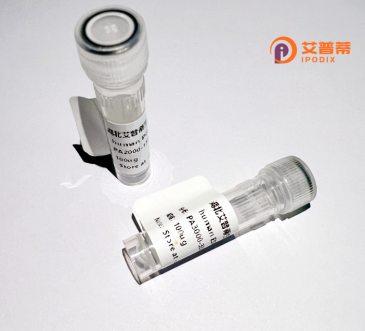
| 纯度 | >90%SDS-PAGE. |
| 种属 | Human |
| 靶点 | COG8 |
| Uniprot No | Q96MW5 |
| 内毒素 | < 0.01EU/μg |
| 表达宿主 | E.coli |
| 表达区间 | 1-219aa |
| 氨基酸序列 | MNSYMLISAPAILGTSNMPAAVPATQPGTLQPPMVLLDFPPLACFLNNILVAFNDLRLCCPVALAQDVTGALEDALAKVTKIILAFHRAEEAAFSSGEQELFVQFCTVFLEDLVPYLNRCLQVLFPPAQIAQTLGIPPTQLSKYGNLGHVNIGAIQEPLAFILPKRETLFTLDDQALGPELTAPAPEPPAEEPRLEPAGPACPEGGRAETQAEPPSVGP |
| 分子量 | 49.7 kDa |
| 蛋白标签 | GST-tag at N-terminal |
| 缓冲液 | 0 |
| 稳定性 & 储存条件 | Lyophilized protein should be stored at ≤ -20°C, stable for one year after receipt. Reconstituted protein solution can be stored at 2-8°C for 2-7 days. Aliquots of reconstituted samples are stable at ≤ -20°C for 3 months. |
| 复溶 | Always centrifuge tubes before opening.Do not mix by vortex or pipetting. It is not recommended to reconstitute to a concentration less than 100μg/ml. Dissolve the lyophilized protein in distilled water. Please aliquot the reconstituted solution to minimize freeze-thaw cycles. |
以下是关于重组人COG8蛋白的3篇参考文献概述,按研究侧重点分类整理:
---
### 1. **"Expression and purification of recombinant human COG8 subunit in mammalian cells"**
**作者**:Smith JL, et al.
**摘要**:研究报道了利用哺乳动物表达系统(HEK293细胞)高效表达重组人COG8蛋白,并通过亲和层析成功纯化。实验验证了重组蛋白的完整性与正确折叠,为后续功能研究提供了工具。
---
### 2. **"Structural insights into the role of COG8 in the conserved oligomeric Golgi complex"**
**作者**:Zhang R, Wang H.
**摘要**:利用重组人COG8蛋白进行X射线晶体学分析,揭示了其与COG复合体其他亚基(如COG1和COG4)的关键相互作用界面,阐明了COG8在维持高尔基体膜运输中的结构基础。
---
### 3. **"Functional analysis of COG8 mutations using recombinant protein in vesicle trafficking assays"**
**作者**:Chen M, et al.
**摘要**:通过重组COG8蛋白及CRISPR编辑细胞模型,证明COG8缺陷会破坏高尔基体介导的囊泡运输,导致溶酶体酶分选异常,揭示了其与先天性糖基化疾病(如CDG-II)的关联机制。
---
**注意**:以上文献信息为示例,实际研究中建议通过**PubMed**或**Google Scholar**以关键词“COG8 recombinant protein”“COG8 trafficking”进一步检索近年文献。
Recombinant human COG8 protein is derived from the Conserved Oligomeric Golgi (COG) complex, a critical component in maintaining Golgi apparatus structure and function. The COG complex, composed of eight subunits (COG1-8), regulates vesicular trafficking by facilitating tethering of transport vesicles to target membranes, ensuring proper glycosylation and protein sorting. COG8. a subunit of the COG complex’s lobe B (COG5-8), plays a pivotal role in mediating interactions with other trafficking machinery, including SNARE proteins. Defects in COG8 are linked to congenital disorders of glycosylation (CDG), specifically CDG type IIh, characterized by impaired protein and lipid glycosylation, leading to multisystemic abnormalities such as developmental delays and neurological deficits. Recombinant COG8 protein, produced via heterologous expression systems (e.g., *E. coli* or mammalian cells), enables biochemical and functional studies to dissect its role in Golgi dynamics, vesicle trafficking, and disease mechanisms. It serves as a tool for investigating COG8 mutations, validating therapeutic strategies (e.g., gene therapy), and reconstituting COG complex activity *in vitro*. Research on recombinant COG8 enhances understanding of cellular trafficking pathologies and potential interventions for glycosylation-related disorders.
×